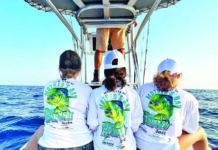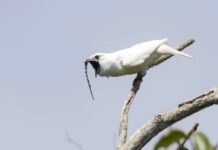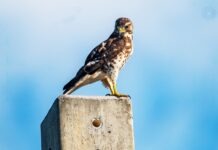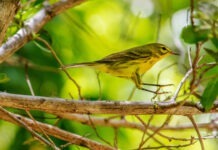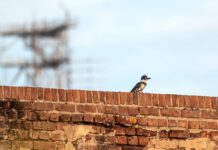
Ducks scare me.
Some people might be tempted to get Freudian about this, and think it has to do with male ducks’ often outsized corkscrew genitalia, and the fact that it can be up to half the length of a duck’s body. But no, that is not it. That is just the glory of nature.
It’s the female ducks that scare me the most, but immature ducks are not far behind — and sometimes males in nonbreeding plumage.
I don’t fear them physically. I mean, what harm could a duck really do to you, other than annoy you with their quacking and ankle biting? (Swans and geese, on the other hand…) And ducks mostly just want to be left alone, which I get and respect.
Birdwatching, though, is generally about trying to understand what you are looking at, and particularly what species it is. And the female ducks, immature ducks and nonbreeding males of a few species tend to look pretty much the same as those from a few other species. It’s a zone of no clear answers, which can lead to an identification quagmire, which can lead to feelings of stupidity and confusion, as well as emotional despair. All of which I fear because I get enough of that in my everyday life.
Last week I was at the Key West Tropical Forest & Botanical Garden with Ellen Westbrook and Mark Songer. We saw a lone duck in the pond. It had that kind of mottled plumage that some female, juvenile and nonbreeding dabbling ducks get — a varying canvas of feathers that ranged from chestnut brown to a light cocoa, most edged with a lighter band of a soapstone or taupe hue. With its head tucked, it resembled a sort of floating tweed shoe. And I just thought, “Oh, a blue-winged teal,” which is one of the two more common ducks we get in the Keys, and I moved along.
But then we saw the duck again from a different angle. It was awake and looking around. It had eye arcs, but pale ones. And an eyeline, though not a particularly strong one.
The bill, though. It didn’t look right for blue-winged teal. It was dark on top and looked to be a little pale underneath. But it also was too big, too heavy. So it had to be a northern shoveler, named for its shovel-like bill, and the second of the two dabbling duck species common in the Keys. Mystery solved, identification established. Except …
Was the bill hefty enough to be a shoveler bill? It looked more shovel-esque than shovel-like.
I wished I had a printed field guide in my back pocket instead of an app on my phone. I mean, an app is great 99% of the time, and it certainly makes your shorts less likely to droop, but there are times you just want to flip through a section of a printed field guide a glossy page at a time, eliminating and considering the possibilities. You can sort of do that with a phone, but it takes a lot of arrhythmic swiping and scrolling, and is much less orderly, effortless and satisfying.
Eventually we eliminated the northern shoveler, both because the bill wasn’t quite right and because a shoveler would have orange legs. (The legs on this duck, which we could occasionally see paddling underwater, were too far on the yellow end of the spectrum.)
After a lot of swiping and scrolling, we all kind of got to the idea of cinnamon teal. A female cinnamon has a not-particularly-strong eye arc, though not much of an eyeline. But an immature cinnamon teal has both the eye arc and something of an eyeline.
I took a lot of pictures, and we all spent a long time staring, settling into the idea of it being a cinnamon teal the way you would settle into an unsteady and untrustworthy chair.
The thing about the cinnamon teal is it is a western species, breeding in places like Montana, Oregon and Colorado. Until 1992 there were only 45 sightings in Florida. The species has been seen with more regularity since, especially in places like Merritt Island National Wildlife Refuge, where it is reported nearly every year. But before 1992 there were no confirmed sightings in the Florida Keys, and eBird only showed one sighting in the Keys in 2014. So it might be the first cinnamon teal recorded in the Lower Keys, and the second one in all of the Keys.
When I got home I pulled out a few field guides to see if I could gain some clarity and maybe feel a little more confident in our ID. The Stokes Field Guide to Birds seemed to back up the idea of it being a cinnamon teal, but the National Geographic Guide to the Birds of North America just muddied the waters for me. (The Nat Geo guide does that a lot, which is one of the reasons I’m not a big fan of the guide.)
Finally, in frustration, I texted a photo of the bird with a note saying, “Do you have any opinion on this duck?” to my friend Rafael Galvez, one of the world’s finer bird artists and generally a walking encyclopedia of avian knowledge.
He texted back a few minutes later saying he was at the DMV, but he had run it through the Merlin app, which has software that is generally (but not always) accurate for identifying birds. It said cinnamon teal. That cheered me up a bit, as it was nice to know someone as smart as Rafael didn’t have a snap conclusion about the bird, either. But it also surprised me a bit. Rafael uses the Merlin app?
But Rafael is one of the more thorough people I know, and a few minutes later he sent a link to a nearly 2,000-word article parsing the difference between female/juvenile blue-winged teals and female/juvenile cinnamon teals. And then he sent a note about the photo, saying the lightness of the eyes, the paleness of the eye arc and the eyeline, the fact that the eyeline didn’t run all the way to the nape, and the heftiness of the bill, all looked good for cinnamon teal.
Which made me feel a lot more confident. It looked good for cinnamon teal. Probably.





